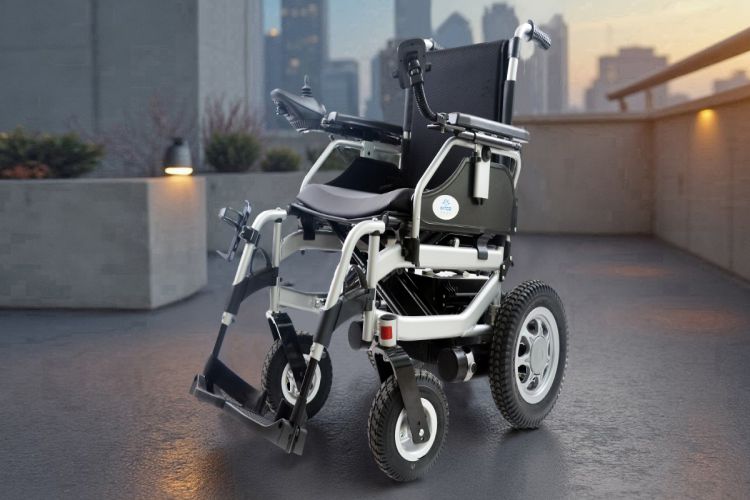Choosing the right power wheelchair isn’t just about picking the flashiest model or the one with the most features; it’s about finding the one that fits you. Your lifestyle, mobility needs, environment, and personal preferences all play a big part in making the right choice. Whether you’re upgrading from a manual chair or looking at powered mobility for the first time, this guide will help steer you in the right direction.
Why Go Electric?
Power wheelchairs (also called electric wheelchairs or motorized wheelchairs) offer greater independence and ease of movement, especially for people who might not have the upper-body strength or stamina to self-propel a manual chair. With the right powerchair, you can move around your home, workplace, or local community with less effort and more freedom.
-
Start with Your Lifestyle and Environment
Think about where you’ll use your chair most often. Are you mainly indoors, or do you need something that can handle outdoor terrain? Will you be navigating tight spaces, curbs, ramps, or long distances?
- Indoor use: Choose a compact model with a tight turning radius, perfect for getting around tight doorways, kitchens, and bathrooms.
- Outdoor use: Look for larger wheels, robust suspension, and a more powerful motor that can handle uneven ground, slopes, or gravel.
- Mixed use: Many people need a chair that does a bit of both. In this case, consider a mid-wheel drive chair – it offers a balance between manoeuvrability and outdoor performance.
Also, think about the weather in your area. While most powerchairs are fine in light rain, regular exposure to the elements (like sand, water, or heat) might call for a heavy-duty model.
-
Understand Drive Types: Rear, Mid, or Front?
There are three main drive configurations, and each one behaves differently.
- Rear-wheel drive: Offers good speed and stability, especially outdoors. Great for people who like a more predictable ride.
- Mid-wheel drive: Has the tightest turning radius – ideal for indoor use. These are often preferred by people who need precise control in smaller spaces.
- Front-wheel drive: Good for climbing small obstacles like curbs. These chairs can take a bit more practice to master, but can be handy outdoors.
-
Check Seating and Comfort Features
You’re likely to spend a fair bit of time in your chair, so comfort is key. Look out for:
- Adjustable seating: Seat width, depth, height, and backrest angle can usually be customized.
- Cushioning and support: Pressure relief cushions or contoured seating can help prevent discomfort or pressure sores, especially for full-time users.
- Power seat functions: Some models offer tilt, recline, seat elevation, or even standing capabilities. These features can help with posture, transfers, and accessing different heights, but they often add to the cost.
Tip: If you’re eligible under the NDIS, some advanced seating options may be covered with the right recommendation from a therapist.
-
Battery Range and Charging Needs
Power wheelchairs run on rechargeable batteries, and the distance you can travel on a full charge varies by model.
- Standard chairs may give you 15–25 km per charge.
- Heavy-duty or outdoor chairs can sometimes reach 30 km or more.
Make sure to match your chair’s range to your daily routine. If you’re out and about most of the day, you’ll want a chair that won’t leave you stranded. Also consider charging time – some chairs can take 8 hours or more to fully charge, so overnight charging is common.
-
Transport and Storage
Some power wheelchairs are bulky and hard to transport. If you travel regularly, look for:
- Foldable or disassemblable designs: These are more compact and can fit in a car boot or be taken on planes and public transport.
- Travel powerchairs: Lightweight and built specifically for portability, though they usually have smaller batteries and fewer features.
On the flip side, full-size or heavy-duty chairs often need a vehicle with a ramp or hoist for transport.
-
Control Options and Accessories
Most powerchairs use a joystick control, usually mounted on the armrest. But there are other options for users with limited hand movement, such as:
- Head controls
- Chin or sip-and-puff systems
- Touchscreen or switch-based systems
Some chairs also come with handy accessories like:
- USB charging ports
- Cup holders
- Oxygen tank holders
- Storage pouches or trays
Think about what would make your life easier day-to-day and ask your supplier or therapist about custom add-ons.
-
Budget and Funding Options
Power wheelchairs can range from a few thousand dollars to well over $20,000, depending on features. But if you’re in Australia, you might be eligible for funding support through:
- NDIS (National Disability Insurance Scheme)
- DVA (Department of Veterans’ Affairs)
- MASS (Medical Aids Subsidy Scheme) – QLD only
- TAC (Transport Accident Commission – VIC)
A good supplier can help you with quotes and documentation to apply for funding. It’s also wise to get an assessment from an occupational therapist – in many cases, this is required for NDIS applications.
-
Try Before You Buy
Finally, don’t just rely on specs or photos – if possible, try the chair. Many suppliers offer home trials or showroom visits. This gives you a feel for how the chair handles, how comfortable it is, and whether it suits your living environment.
Final Thoughts
Choosing the best power wheelchair is a big decision, but it’s also an investment in your independence and quality of life. By taking the time to assess your needs, talk with professionals, and test out a few options, you’ll be in the best position to find the right fit.
Whether you need something lightweight for travel, robust for outdoor use, or fully customised for daily living, there’s a powerchair out there designed just for you.

